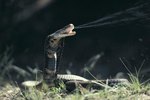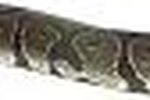
Most snakes have poor vision. They must rely instead on other senses when hunting prey, seeking a mate or determining danger. One of these senses is that of smell. Although a snake has a pair of nostrils, his nose is used primarily for respiration. A snake smells his surroundings with a combination of his tongue and an enhanced olfactory organ.
Sampling the Air
The rostral groove is a small notch in the front of a snake’s lips, which allows for his tongue to easily flick in and out of his closed mouth. When a snake flicks out his tongue, he is smelling the environment. The moist tongue receives tiny particles from the air or surface that it comes into contact with. Those particles make up scents. When the tongue is retracted into the snake’s mouth, it transmits those particles to be processed and analyzed by a chemoreceptive organ of the olfactory system.
Jacobson’s Organ
The forks on a snake’s tongue are designed to fit into two holes in the roof of his mouth. These holes access the Jacobson’s organ, named after the Danish scientist who discovered it. This organ is a group of sensory receptor cells located in the palate. Once the scent particles are passed from the forks of the snake’s tongue into the Jacobson’s organ, the chemical compounds are processed and the sensory analysis is transmitted to the brain. Together, the tongue and Jacobson’s organ make up the snake’s vermonasal system, enabling him to rely on his sense of smell.
Follow the Tongue
The snake’s vermonasal system serves several purposes. He can track down hunted prey to keep himself fed. He can also identify enemies that may be lurking, granting him an opportunity for a safe escape. During mating season, male snakes use their olfactory abilities to detect the pheromones of females. Young snakes may follow the pheromone trail to identify their way back to the nest. When the snake’s tongue is inserted into the ducts of the Jacobson’s organ, the scents of each fork are analyzed independently. This feature guides the snake’s direction of movement based on which fork deposited a higher concentration of the scent.
Just Checking You Out
Due to the snake’s minimal visual and auditory capabilities, he relies on touch and smell for nearly every activity. Once a snake feels vibrations in the ground that signal movement of an approaching individual, his tongue begins flickering rapidly to quickly assess the smells that it picks up. Next time you encounter a snake who gazes at you while waving his tongue incessantly in your direction, he is simply giving you a sniff to determine if you are prey or foe.
References
Photo Credits
-
Visage/Stockbyte/Getty Images



